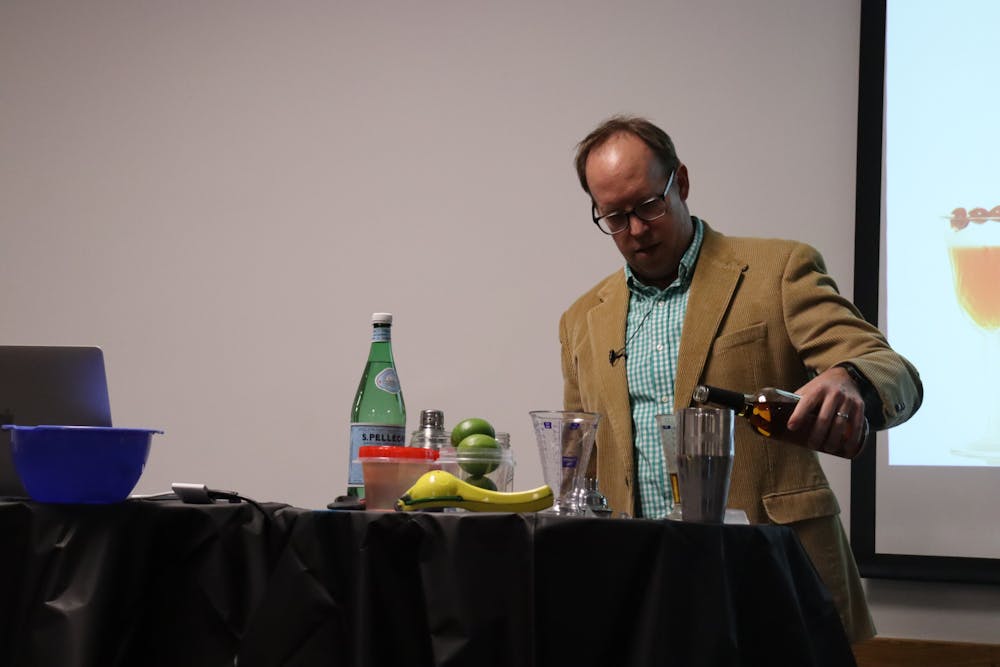Students learned the art of mocktails and cocktails, informed by the chemistry of taste and smell, on Nov. 8 at Bender Library.
Matthew Hartings, an associate professor in the Department of Chemistry, taught audience members tips for combining flavors and how their brains determine taste based on smell. Students mixed ingredients and ate snacks in the Library’s lower-level lounge for the event, which was a part of the Library’s SciPop Talks series.
“[Molecules] make a pattern that our brain recognizes,” Hartings said. “And our brain says, ‘Strawberry.’”
Flavor molecules float from the mouth to the nose because they’re hydrophobic and lightweight, “so when we put them into our mouths, they naturally come up out of the liquid and then just will wind their way through your nose,” Hartings said.
After explaining the science behind cocktail making, Hartings made a Manhattan and the Rickey — the official cocktail of D.C. — in front of the audience. He said diluting the ingredients in water, shaking the container the proper amount and stopping when the container begins to ice over is his cocktail-making secret.
“When you really know how to make it well, there’s a huge difference,” Hartings said in an interview with The Eagle after the event.
According to Hartings, most cocktails have three ingredients: water, alcohol and a flavor molecule, making it easy for audience members to understand the chemical reactions.
“As far as food and perception of food goes, it’s about as simple as you can get,” he said.
Hartings said he enjoyed seeing students interested in chemistry.
“Normally, when you talk about chemistry, people’s eyes glaze over,” Hartings said. “But when you talk about something that’s chemistry-adjacent or chemistry-informed like food and cocktails are, people get really excited about chemistry and they want to think about chemistry and they want to ask questions about chemistry.”
Ben Wenig, a lab assistant for Hartings and a sophomore in the College of Arts and Sciences, said Hartings’ demonstrations make chemistry lessons more enjoyable.
“Chemistry can be very boring at times, but when it comes to something fun like alcohol, it can be really engaging,” he said.
Hartings’ emphasis on picking flavors for drinks also taught Wenig more about drink mixing, he said.
“I just thought cocktails were kind of a math thing, but I was surprised to learn how much chemistry is involved,” Wenig said. “It’s really about picking the right flavors in proportion, as well.”
For Allison Alayza, a senior in CAS, the behind-the-scenes science was the star of the show. Though Alayza said she wished Hartings talked about the science behind cocktail-making more, she said the opportunity to make her own drinks “was a really nice surprise as well.”
“It was really cool to see science pulled into something that I hadn’t thought of before,” she said.
Lauren Schnizlein, a freshman in CAS and the School of International Service, said she doesn’t often get to explore American University’s science classes. Hartings’ talk allowed her to tap into a field she otherwise doesn’t spend much time in, she said.
“I think AU offering some of these kinds of events where you can just show up and play around with science and kind of be a part of that community without taking those classes is kind of nice,” Schnizlein said.
Hartings said that bringing science to students was one of the goals of the event and that he wants people to think more about chemistry in everyday life.
“I always want people to start really thinking about the chemistry around them,” Hartings said. “If that’s the environment, if that’s thinking about reducing our fossil fuel imprint, if that’s thinking about the food they eat or what they drink; I love it when I can convince people to think about all the chemistry that surrounds them every day.”
This article was edited by Sara Winick, Patricia McGee and Abigail Pritchard. Copy editing done by Isabelle Kravis and Olivia Citarella.





